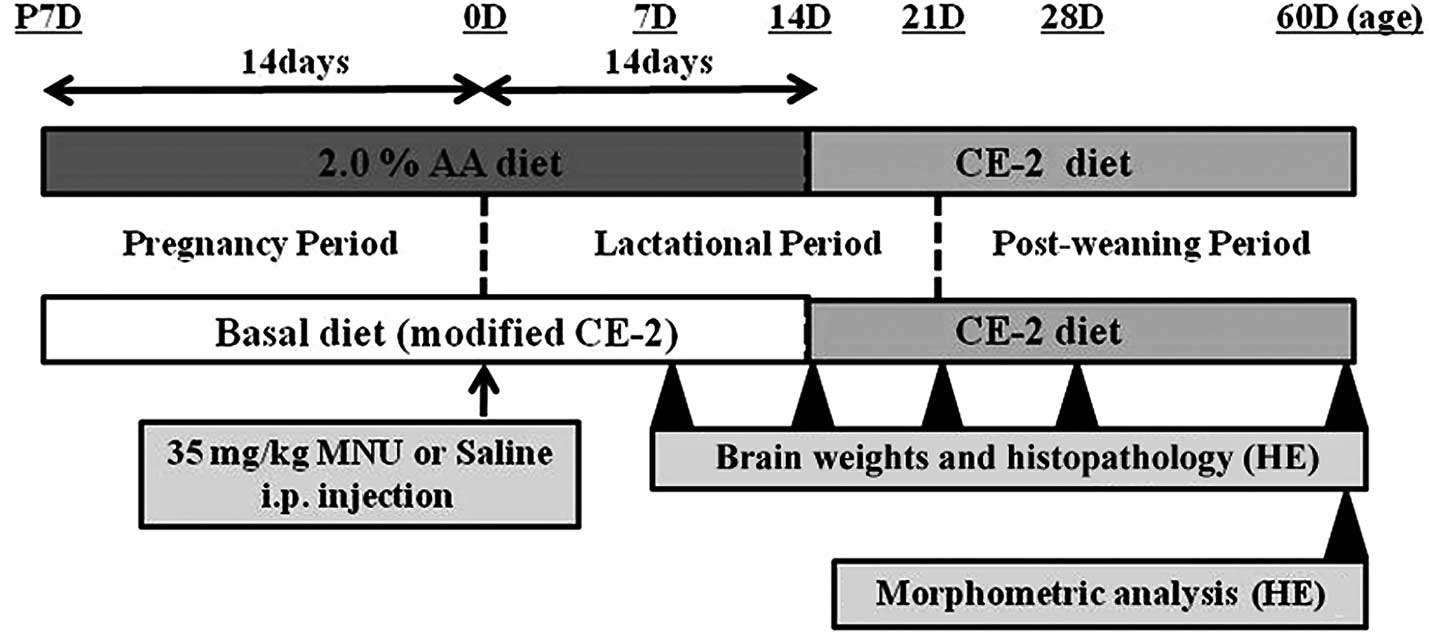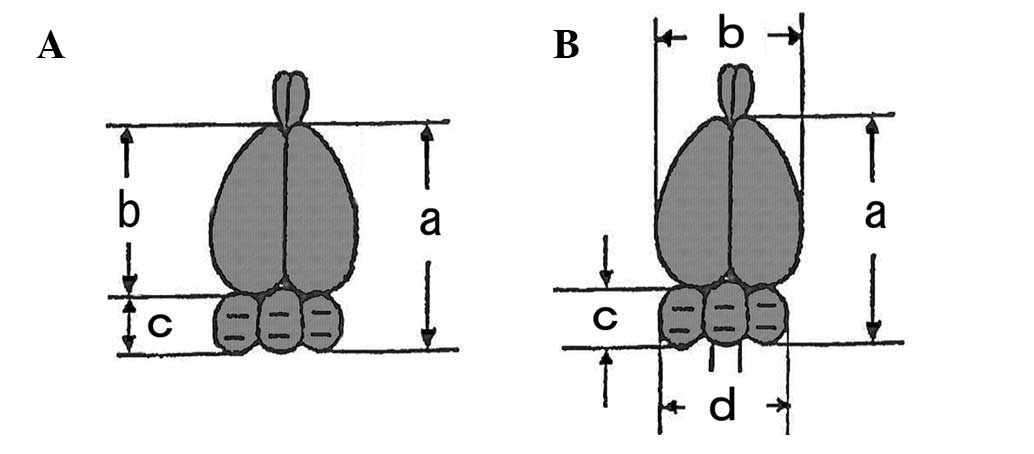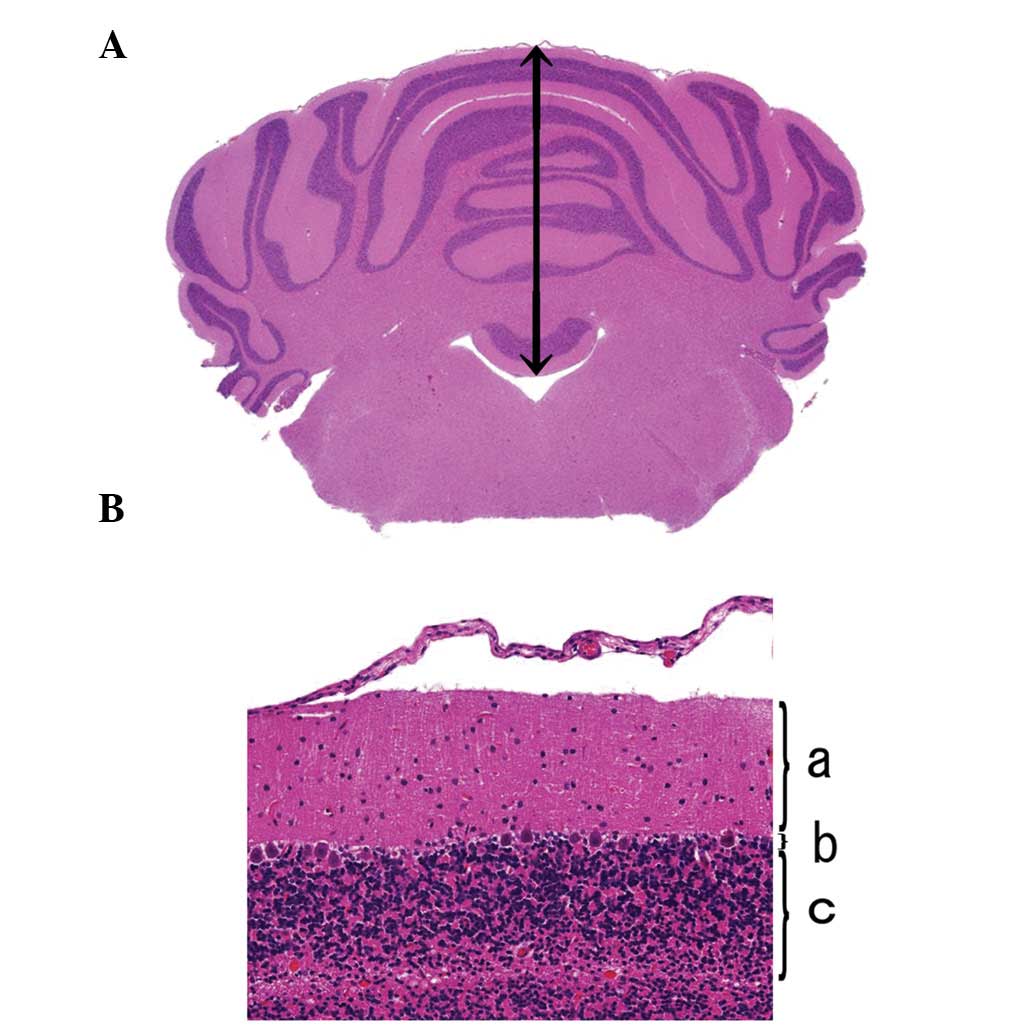|
1
|
Biran V, Verney C and Ferriero DM:
Perinatal cerebellar injury in human and animal models. Neurol Res
Int. 2012:8589292012. View Article : Google Scholar : PubMed/NCBI
|
|
2
|
Safronova MM, Barbot C and Resendepereira
J: Hipoplasias cerebelosas. Acta Med Port. 23:841–852. 2010.(In
Portuguese).
|
|
3
|
Altman J: Morphological and behavioral
markers of environmentally induced retardation of brain
development: an animal model. Environ Health Perspect. 74:153–168.
1987. View Article : Google Scholar : PubMed/NCBI
|
|
4
|
Ogura H, Mikami T, Takamura N, Suzuki Y
and Chiba T: Development of behavioral function of cerebellar
hypoplasia rats as induced by cytosine arabinoside (ara-C). Nihon
Yakurigaku Zasshi. 76:33–44. 1980.(In Japanese).
|
|
5
|
Ramaekers VT, Heimann G, Reul J, Thron A
and Jaeken J: Genetic disorders and cerebellar structural
abnormalities in childhood. Brain. 120:1739–1751. 1997. View Article : Google Scholar : PubMed/NCBI
|
|
6
|
Kodama M, Fujiyama F, Yamada S, Shiota K
and Nagao T: Methylnitrosourea induces neural progenitor cell
apoptosis and microcephaly in mouse embryos. Birt Defects Res B Dev
Reprod Toxicol. 89:213–222. 2010.PubMed/NCBI
|
|
7
|
Kimura A, Yoshizawa K, Sasaki T, Uehara N,
Kinoshita Y, Miki H, Yuri T, Uchida T and Tsubura A:
N-methyl-N-nitrosourea-induced changes in epithelial rests of
Malassez and the development of odontomas in rats. Exp Ther Med.
4:15–20. 2012.PubMed/NCBI
|
|
8
|
Tsubura A, Lai YC, Miki H, Sasaki T,
Uehara N, Yuri T and Yoshizawa K: Animal models of
N-methyl-N-nitrosourea-induced mammary cancer and retinal
degeneration with special emphasis on therapeutic trials. In Vivo.
25:11–22. 2011.PubMed/NCBI
|
|
9
|
Yoshizawa K, Emoto Y, Kinoshita Y, Kimura
A, Uehara N, Yuri T, Shikata N, Hamazaki T and Tsubura A:
Arachidonic acid supplementation does not affect
N-methyl-N-nitrosourea-induced renal preneoplastic lesions in young
Lewis rats. Oncol Lett. 5:1112–1116. 2013.PubMed/NCBI
|
|
10
|
Yoshizawa K, Uehara N, Kimura A, Emoto Y,
Kinoshita Y, Yuri T, Takada H, Moriguchi T, Hamazaki T and Tsubura
A: Promoting effect of arachidonic acid supplementation on
N-methyl-N-nitrosourea-induced pancreatic acinar cell hyperplasia
in young Lewis rats. Oncol Lett. 5:76–82. 2013.PubMed/NCBI
|
|
11
|
Singla N and Dhawan DK:
N-methyl-N-nitrosourea induced functional and structural
alterations in mice brain - role of curcumin. Neurotox Res.
22:115–126. 2012. View Article : Google Scholar : PubMed/NCBI
|
|
12
|
Kleihues P and Patzschke K: Distribution
of N-(14C) methyl-N-nitrosourea in the rat after its
systemic administration. Z Krebsforsch. 75:193–200. 1971.(In
German).
|
|
13
|
Shibutani M, Maekawa A, Okeda R, Mitsumori
K, Imazawa T, Yoshiza J, Onodera H and Hayashi Y: An experimental
model for anaplastic astrocytomas and glioblastoma using adult F344
rats and N-methyl-N-nitrosourea. Acta Pathol Jpn. 43:464–474.
1993.PubMed/NCBI
|
|
14
|
Becker K, Dosch J, Gregel CM, Martin BM
and Kaina B: Targeted expression of human
O6-methylguanine-DNA ethyl transferase (MGMT) in
transgenic mice protects against tumor initiation in two-stage skin
carcinogenesis. Cancer Res. 56:3244–3249. 1996.PubMed/NCBI
|
|
15
|
Kidney JK and Faustman EM: Modulation of
nitrosourea toxicity in rodent embryonic cells by O6-benzylguanine,
a depletory of O6-methylguanine-DNA
methyltransferase. Toxicol Appl Pharmacol. 133:1–11. 1995.
View Article : Google Scholar : PubMed/NCBI
|
|
16
|
Schleifer S and Tempel K: Formation and
persistence of N7- and O6-methyl-guanine in
DNA of chick embryo brain cells in ovo following
administration of N-nitroso-N-methylurea. Zentralbl Veterinarmed A.
43:589–598. 1996.
|
|
17
|
Fujiyama F, Saito Y and Nagao T: Effects
of prenatal exposure to methyl nitrosourea on the developing brains
of mouse offspring. Congenit Anom (Tokyo). 47:A292007.
|
|
18
|
Fujimori K, Inoue K, Nakazawa K, Maekawa
A, Shibutani M and Takanaka A: Neurochemical and histological
analysis of motor dysfunction observed in rats with
methylnitrosourea-induced experimental cerebellar hypoplasia.
Neurochem Res. 17:223–231. 1992. View Article : Google Scholar
|
|
19
|
Smith SB, Brown CB, Wright ME and Yielding
KL: Late-onset cerebellar degeneration in mice induced
transplacentally by methylnitrosourea. Teratog Carcinog Mutagen.
7:449–463. 1987. View Article : Google Scholar : PubMed/NCBI
|
|
20
|
Smith SB, Cooke CB and Yielding KL: The
antioxidant butylated hydrotoluene can retard cerebellar
degeneration induced transplacentally by a single low dosage of
N-methyl-N-nitrosourea. Teratog Carcinog Mutagen. 9:15–27. 1989.
View Article : Google Scholar : PubMed/NCBI
|
|
21
|
Arterburn LM, Hall EB and Oken H:
Distribution, interconversion, and dose response of n-3 fatty acids
in humans. Am J Clin Nutr. 83(Suppl): 1467S–1476S. 2006.PubMed/NCBI
|
|
22
|
Semba RD: Essential fatty acids and visual
development in infants. Handbook of Nutrition and Ophthalmology.
Humana Press; New Jersey: pp. 415–441. 2007
|
|
23
|
Davis-Bruno K and Tassinari MS: Essential
fatty acid supplementation of DHA and ARA and effects on
neurodevelopment across animal species: a review of the literature.
Birth Defects Res B Dev Reprod Toxicol. 92:240–250. 2012.
View Article : Google Scholar : PubMed/NCBI
|
|
24
|
Saste MD, Carver JD, Stockard JE, Benford
VJ, Chen LT and Phelps CP: Maternal diet fatty acid composition
affects neurodevelopment in rat pups. J Nutr. 128:740–743.
1998.PubMed/NCBI
|
|
25
|
Maekawa M, Takashima N, Matsumata M,
Ikegami S, Kontani M, Hara Y, Kawashima H, Owada Y, Kiso Y,
Yoshikawa T, Inokuchi K and Osumi N: Arachidonic acid drives
postnatal neurogenesis and elicits a beneficial effect on prepulse
inhibition, a biological trait of psychiatric illnesses. PLoS ONE.
4:e50852009. View Article : Google Scholar : PubMed/NCBI
|
|
26
|
Osumi N: Fatty acid signal, neurogenesis,
and psychiatric disorders. Nihon Shinkei Seishin Yakurigaku Zasshi.
30:141–148. 2010.(In Japanese).
|
|
27
|
Hoffman DR, Boettcher JA and
Diersen-Schade DA: Toward optimizing vision and cognition in term
infants by dietary docosahexaenoic and arachidonic acid
supplementation: a review of randomized controlled trials.
Prostaglandins Leukot Essent Fatty Acids. 81:151–158. 2009.
View Article : Google Scholar : PubMed/NCBI
|
|
28
|
Uauy R, Hoffman DR, Peirano P, Birch DG
and Birch EE: Essential fatty acids in visual and brain
development. Lipids. 36:885–895. 2001. View Article : Google Scholar : PubMed/NCBI
|
|
29
|
Yoshizawa K, Nambu H, Yang J, Oishi Y,
Senzaki H, Shikata N, Miki H and Tsubura A: Mechanisms of
photoreceptor cell apoptosis induced by N-methyl-N-nitrosourea in
Sprague-Dawley rats. Lab Invest. 79:1359–1367. 1999.PubMed/NCBI
|
|
30
|
Yoshizawa K and Tsubura A: Characteristics
of N-methyl-N-nitrosourea-induced retinal degeneration in animals
and application for the therapy of human retinitis pigmentosa.
Nippon Ganka Gakkai Zasshi. 109:327–337. 2005.(In Japanese).
|
|
31
|
Yoshizawa K, Sasaki T, Kuro M, Uehara N,
Takada H, Harauma A, Ohara N, Moriguchi T and Tsubura A:
Arachidonic acid supplement during gestational, lactational and
post-weaning periods prevents retinal degeneration induced in a
rodent model. Br J Nutr. 109:1424–1432. 2013. View Article : Google Scholar
|
|
32
|
Bolon B, Garman R, Jensen K, Krinke G and
Stuart B: A ‘best practices’ approach to neuropathologic assessment
in developmental neurotoxicity testing - for today. Toxicol Pathol.
34:296–313. 2006.
|
|
33
|
Kaufmann W, Bolon B, Bradley A, Butt M,
Czasch S, Garman RH, George C, Groters S, Krinke G, Little P, McKay
J, Narama I, Rao D, Shibutani M and Sills R: Proliferative and
nonproliferative lesions of the rat and mouse central and
peripheral nervous systems. Toxicol Pathol. 40(Suppl): 87S–157S.
2012. View Article : Google Scholar : PubMed/NCBI
|
|
34
|
Rice D and Barone S Jr: Critical periods
of vulnerability for the developing nervous system: evidence from
humans and animal models. Environ Health Perspect. 108(Suppl 3):
S511–S533. 2000. View Article : Google Scholar : PubMed/NCBI
|
|
35
|
Fujimori K, Sunouchi M, Inoue K, Nakadate
M, Takanaka A and Omori Y: Cytotoxic effects of methylnitrosourea
on developing brain. Neurochem Res. 8:193–206. 1983. View Article : Google Scholar : PubMed/NCBI
|
|
36
|
Report of the 28th session of the Codex
Committee on Nutrition and Foods for Special Dietary Uses. Joint
FAO/WHO Food Standards Programme, Codex Alimentarus Commission;
2007
|
|
37
|
Moriguchi T, Loewke J, Garrison M, Catalan
JN and Salem N Jr: Reversal of docosahexaenoic acid deficiency in
the rat brain, retina, liver, and serum. J Lipid Res. 42:419–427.
2001.PubMed/NCBI
|
|
38
|
Sakayori N, Maekawa M, Numayama-Tsuruta K,
Katura T, Moriya T and Osumi N: Distinctive effects of arachidonic
acid and docosahexaenoic acid on neural stem/progenitor cells.
Genes Cells. 16:778–790. 2011. View Article : Google Scholar : PubMed/NCBI
|
|
39
|
Katsuki H and Okuda S: Arachidonic acid as
a neurotoxic and neurotrophic substance. Prog Neurobiol.
46:607–636. 1995. View Article : Google Scholar : PubMed/NCBI
|
|
40
|
Kim HY, Akbar M and Kim KY: Inhibition of
neuronal apoptosis by polyunsaturated fatty acids. J Mol Neurosci.
16:223–278. 2001. View Article : Google Scholar : PubMed/NCBI
|
|
41
|
Imai N, Kawabe M, Tamano S, Doi Y,
Nakashima H, Suguro M, Numano T, Hara T, Hagiwara A, Furukawa F,
Kaneda Y, Tateishi N, Fujii W, Kawashima H, Shibata H and
Sakakibara Y: Arachidonate-enriched triglyceride oil does not
promote tumor development in a rat medium-term multi-organ
carcinogenesis model. Food Chem Toxicol. 50:2780–2791. 2012.
View Article : Google Scholar : PubMed/NCBI
|


















